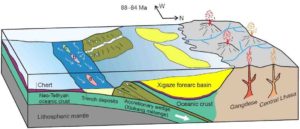
The Jiachala Formation, which was fed largely from the Gangdese arc, has long been considered to comprise syn-collisional foreland-basin deposits based on the reported occurrence of Paleocene-early Eocene dinoflagellate cysts and pollen assemblages. Because magmatic activity in the Gangdese arc continued through the Late Cretaceous and Paleogene, this scenario is incompatible with U-Pb ages of detrital zircons invariably older than the latest Cretaceous.
In order to solve this incongruence and constrain the depositional age and tectonic setting of the Jiachala Formation, a new study was carried out with stratigraphic, sedimentological, provenance analysis including sandstone petrography, detrital zircon U-Pb age and Hf isotopic data. Paleontological analysis was conducted by Prof. Xiumian Hu’s group at Nanjing University.
According to this research, the Jiachala Formation was originally deposited on a submarine fan in the trench environment at the active southern margin of the Asian plate. Sandstone petrography, detrital-zircon U-Pb ages and Hf isotope ratios indicate provenance from the Gangdese arc and the central Lhasa terrane. Because magmatic activity in the Gangdese arc was virtually continuous, the youngest population of detrital zircons contained in the Jiachala Formation constrain its depositional age as Late Cretaceous (~88-84 Ma). What’s more, based on the U-Pb age spectra of detrital zircons and sandstone petrography, there are no Paleocene-Eocene units similar to the Jiachala Formation that compare well with Upper Cretaceous exposed within and close to the Yalung Zangbo suture zone (Figure 1).
Integrated geological information indicates that the Jiachala Formation accumulated in the Neo-Tethyan trench during subduction of oceanic lithosphere (Figure 1).In summary, this research gives a new interpretation about the Jiachala Formation and enriches the case study of the arc trench system of the active Asian continental margin.
Reference:
Hanpu Fu et al, Upper Cretaceous trench deposits of the Neo-Tethyan subduction zone: Jiachala Formation from Yarlung Zangbo suture zone in Tibet, China, Science China Earth Sciences (2018). DOI: 10.1007/s11430-017-9223-5
Note: The above post is reprinted from materials provided by Science China Press.










